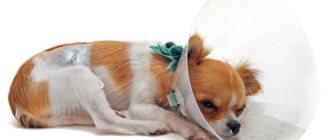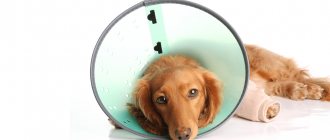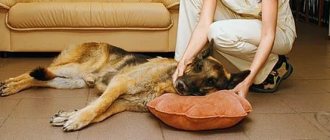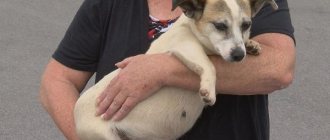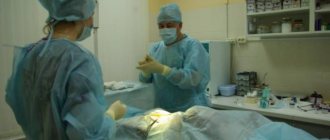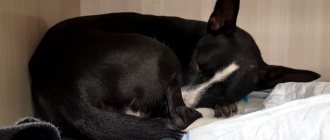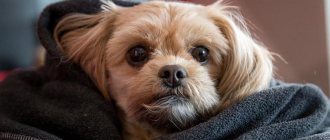How to care for your dog after pyometra surgery
In order to provide the animal with proper care after surgery, it is necessary to have at least a general idea of what exactly it involved.
At its core, an operation to treat pyometra is the same as sterilization, but, unlike the planned removal of a female’s reproductive organs, in this case the procedure is often carried out urgently, on an urgent basis, which excludes the possibility of conducting a full examination of the animal and carefully preparing it for surgery intervention and, accordingly, minimize all possible risks and complications.
Important! Surgical treatment of pyometra in dogs is carried out exclusively by supravaginal ovariohysterectomy, i.e. complete removal of the uterus, fallopian tubes and ovaries. Of course, the animal’s reproductive function is not preserved after this.
The accumulation of pus in the mucous membrane of the uterus is in itself very dangerous, since it is often the direct cause of rupture of its walls and the outpouring of exudate filled with pathogenic bacterial microflora into the abdominal cavity. At the same time, the dog very quickly begins to develop sepsis (infection in the blood) and peritonitis (acute inflammation of the peritoneum), and this, in turn, without urgent surgical intervention inevitably leads to the death of the animal.
Thus, despite the fact that ovariohysterectomy itself is a simple operation that is performed in veterinary clinics almost every day, if the indication for the procedure is purulent inflammation of the uterus, the situation becomes radically more complicated.
In addition, sometimes a dog with pyometra is admitted to the hospital in extremely serious condition, which does not allow the animal to be immediately placed on the operating table and requires stabilization measures - emergency infusion therapy to relieve general intoxication, restore water-salt balance (rehydration), etc. . All these procedures can also significantly complicate both the operation itself and the dog’s recovery in the postoperative period.
There are three main methods of performing ovariohysterectomy in dogs:
- abdominal surgery with an incision along the white line of the abdomen (in the center);
- abdominal surgery with an incision along the lateral line;
- laparoscopy (removal of reproductive organs through a small hole using a laparoscope - a special optical tube and a video camera attached to it).
The specific method of performing the procedure is chosen by the surgeon, based on his own professional experience and personal preferences, as well as the equipment available in the clinic. However, the complexity of subsequent recovery largely depends on the method of performing the surgical procedure. Thus, a lateral incision during abdominal surgery is traditionally considered less traumatic and, accordingly, less likely to cause postoperative complications.
Did you know? Laparoscopy is often called “keyhole surgery” and surgery without scars or pain. The first such operation was performed back in 1910 by the Swedish doctor Hans Christian Jacobeus.
Laparoscopy, in turn, facilitates the healing process of the wound and minimizes the likelihood of infection, but at the same time carries additional risks associated with the limited range of motion of the surgeon, the distorted picture that he sees in front of him, the inability to work with his hands (from -through a small incision, it is necessary to remove the uterus and ovaries using special instruments, which requires filigree skills, dexterity and good intuition). As a result, laparoscopic operations are most often accompanied by injury to tissues and internal organs, and the doctor often does not even notice this.
Recovery from anesthesia
Regardless of the method used to remove (estrip) the uterus and ovaries, surgical treatment of purulent endometritis always involves the use of general anesthesia, and this is the first risk factor. Ideally, such a procedure should be preceded by a comprehensive examination of the animal, including ultrasound of internal organs, electrocardiogram, laboratory blood tests, etc. in order to assess the anesthetic risk, select the correct drug and identify other factors that may affect the outcome of the operation.
Did you know? The uterus can rightfully be considered one of the most amazing organs in viviparous animals. Being 99% muscle in structure, the uterus is capable of increasing in size tens of times, and after childbirth quickly and painlessly returns to its original size.
However, in practice this does not always happen. This is partly due to subjective factors (negligence of the veterinarian, reluctance to conflict with the client about the need to incur additional costs, etc.), but in the case of urgent treatment of purulent endometritis, there may simply not be time for such an examination, since the animal urgently needs to be saved life. As a result, all risks associated with unsuccessful anesthesia are greatly increased.
The situation is also aggravated by the age factor, because if planned ovariohysterectomy in order to prevent unwanted pregnancy is usually carried out in young bitches (before the first heat), then purulent inflammation of the uterus is a disease that develops in the second half of the animal’s life, when the dog already has a history of a number of chronic diseases , incl. those that are especially dangerous from the point of view of the body’s ability to normally tolerate general anesthesia.
Important! There are no direct contraindications for the use of general anesthesia in veterinary medicine, but pathologies of the cardiovascular and respiratory systems, as well as malignant hyperthermia, allergies and other individual characteristics of the animal require a very responsible approach to the choice of anesthetic drug and its dosage.
The operation of ovariohysterectomy in dogs, according to existing protocols in veterinary medicine, today allows the use of several drugs for anesthesia, each of which has serious side effects.
This information is given in more detail in the table:
| Type of drug | Danger (side effects) |
| Isoflurane | Arrhythmia, hypotension, depressed breathing, convulsions, intestinal obstruction, nausea, vomiting |
| Sevoflurane | Respiratory and cardiac suppression, short-term action (requires additional use of local analgesics) |
| Propofol | Slow heart rate, hypotension, shortness of breath or respiratory arrest, seizures, pulmonary edema, headache, fever, nausea, vomiting, venous thrombosis |
| Zolazepam and Tiletamine | Respiratory arrest, vomiting, severe salivation and cough with copious sputum production, hypertension, tremor, persistent increase in muscle tone |
| Dexmedetomidine | Blood pressure surges, slow heart rate |
Side effects of drugs for general anesthesia, including those caused by an error in dosage, can occur both directly during the operation and in the first hours after its completion, the moment the dog returns to consciousness is especially critical. Therefore, it is extremely important that throughout this entire period, in addition to the surgeon, there is an experienced anesthesiologist next to the animal, ready to help the dog in every possible way to cope with both the emotional and somatic consequences of the dangerous drug.
Did you know? Swedish veterinarians estimate that approximately one in four unspayed female dogs will develop pyometra before the animal reaches 10 years of age. Some breeds are even more likely to experience this and are at risk, including collies, Rottweilers, retrievers and Bernese Shepherds.
The most common problems associated with a dog coming out of anesthesia are:
- long period of awakening;
- hallucinations, disorientation in space;
- allergic reaction to anesthesia in any of its manifestations;
- rapidly developing hypothermia (decrease in body temperature);
- slow breathing and heartbeat until it stops completely.
More rare complications include pulmonary edema and the so-called hospital-acquired or postoperative stroke. The owner of the animal must be warned about all these risks on receipt before the operation.
The veterinarian has the right to hand over the dog to the owner and release the animal for further recovery at home only after he is convinced that none of the alarming symptoms listed above are observed in the animal. Before discharge, the owner should also be provided with detailed information about the algorithm of actions in the first hours and days, while the effects of anesthesia still retain their influence.
As a rule, we are talking about the fact that the animal should not be given water for 5–6 hours, and it is better to postpone the first meal for at least 10 hours. If the dog is very thirsty, it is permissible to wet its tongue with water every half hour or hour.
Important! The time for a dog to recover from anesthesia is always individual. It depends both on the drug used during the operation and its dosage, and on the characteristics of the animal’s body.
However, after surgical treatment of purulent inflammation of the uterus, it is recommended to leave the dog in the veterinary clinic until the next day, in this case all the main difficulties associated with removing the animal from anesthesia will not affect the owner. On average, reversion (return of consciousness, restoration of brain and physical activity) after anesthesia can last in a dog from 2-3 hours to 1-2 days.
Seam care rules
Caring for a postoperative suture is, in fact, one of the most difficult tasks that falls entirely on the dog owner. The first treatment of the wound suturing site is performed by the surgeon immediately after the completion of the ovariohysterectomy. If the sutures are applied skillfully, and no pathogenic microflora has entered the incision site, decay should not begin. However, the greatest danger in terms of wound healing is the animal itself, which instinctively tries to care for the painful area by intensively licking it.
Due to constant friction with a rough tongue, the seams often come apart, but even if this does not happen, the risk of infection is still very high. Therefore, perhaps a more important procedure than the actual antiseptic treatment of the suture is the adoption of measures aimed at depriving the pet of the physical opportunity to reach the site of the surgical incision.
Did you know? The longest surgical operation was performed in 1951 by doctors at the Chicago Hospital. The procedure for removing a huge ovarian cyst from a patient named Gertrude Lewandowski lasted exactly four days, i.e. 96 hours straight.
For this purpose, in the first days after ovariohysterectomy, the dog is put on a special blanket that completely covers the abdomen. This precaution does not have a very good effect on the wound healing process itself, since with constant access to oxygen, tissue restoration occurs much faster than under a bandage, but preventing licking is still much more important. There is an alternative protection option - special collars that are placed around the dog’s neck and do not allow it to reach its stomach with its tongue. Not all animals, however, readily accept this kind of restrictions, so the owner must choose between a blanket and a collar, adapting to the individual characteristics of his pet and trying to cause him minimal emotional discomfort.
As for the direct care of the suture, all measures here come down to periodic (1-2 times a day, depending on the size of the incision and the condition of the wound) treatment of the suture with an antiseptic, for example, a chlorhexidine solution. In some cases, even these procedures are not necessary, although it is always necessary to monitor the healing process and, in particular, the absence of inflammation in the wound.
Important! The frequency of treatment should be increased if the seam does not dry out. But if the wound site produces fluid or purulent exudate, the dog's body temperature rises, or other signs of deterioration in the animal's condition are observed, the pet should be immediately taken to the surgeon who performed the operation or another qualified veterinarian.
The time of suture removal is agreed upon with the surgeon before the animal is discharged home. There is no need to remove so-called cosmetic sutures, since modern suture materials dissolve on their own. In this case, accordingly, a repeat visit to the clinic is not required, which is additional stress for the pet, which should also be considered as a great advantage.
Until the wound heals, it is better for the dog to find a quiet and calm place in the “lower tier” of the room, since jumping, for example, on or off the bed, can cause the postoperative sutures to come apart.
Proper nutrition in the postoperative period
The first few hours after the operation, performed under general anesthesia, you should not feed the dog, so as not to provoke an attack of vomiting. Then, throughout the entire recovery period, the animal should be on a gentle diet - food should be light and well digested, since the large expenditure of energy required by the process of digesting high-calorie foods is harmful for a weakened body. For the same reason, it makes sense to increase the frequency of feeding the animal during the day with a corresponding reduction in the single portion.
Did you know? In 1944, a female American Foxhound named Lana gave birth to 23 puppies, which remains the largest litter of dogs to this day. It is significant that all the children of the “heroine mother” survived.
Another fundamentally important point that should be taken into account when creating a diet is the prevention of constipation. Problems with defecation are accompanied by severe tension in the muscles located in the lower abdomen, and this, in turn, increases the risk of postoperative sutures coming apart. To avoid such a problem, the dog needs to be given a large amount of liquid, and also exclude “dangerous” foods from the diet - rice, bones, rich broths, eggs, fatty meat, etc. As a protein component of the diet, it is better to use rabbit, chicken, veal, and for carbohydrates, give preference to oatmeal.
The specificity of surgical treatment of pyometra is that the result of surgery is actually sterilization. Simultaneously with the loss of reproductive function, complex hormonal changes occur in the animal’s body, which, in particular, result in a significant increase in the risk of obesity.
Therefore, after ovariohysterectomy, the female should definitely be switched to food for sterilized dogs, and when using a natural diet, significant adjustments should be made to it aimed at reducing calorie content. It is best to choose a specific diet for each animal, taking into account its size, age, breed, health status and individual characteristics of the body, together with a veterinarian.
Important! After sterilization in adulthood, the dog is much more likely to gain weight quickly than if the animal was spayed during the first two years of life.
Prevention of complications
The best prevention of any postoperative complications is competent preparation for the procedure (premedication), which includes drawing up a clear action plan with maximum consideration of all pathologies and other nuances present in the animal. The professionalism of the surgeon and anesthesiologist and their conscientiousness are the factors on which the success of surgical treatment and the speed of subsequent recovery depend. But there are moments that the dog owner himself can and should influence.
Several main rules that must be followed when caring for an animal after surgery are as follows:
- in the first hours after recovery from anesthesia, the dog must be forced to blink to avoid drying out the mucous membrane of the eyes (you can simply close the pet’s eyes with your hand for a few seconds or use moisturizing eye drops);
- do not leave the dog alone for a long time, constantly keep the animal in the field of attention (this will prevent falls, injury, licking the seam and other troubles);
- do not allow the pet to make active movements, jump or jump from a height, etc.);
- protect the animal from hypothermia or overheating;
- do not feed the dog for the time recommended by the surgeon, and after it has passed, do not force it to eat if the animal refuses food;
- ensure that your dog has regular bowel movements and ensures that your dog drinks as much as possible;
- do not grab your pet by the belly or pull on the front paws;
- do not try to remove stitches yourself;
- do not use iodine or brilliant green to treat seams;
- do not bathe your pet, but do not allow him to get dirty (it is very important to prevent contamination of an unhealed wound).
Gastrointestinal dysfunction in the first days after surgery occurs quite often in dogs. If the attack of vomiting happened once, there is nothing to worry about, but if the symptoms recur, it is necessary to discuss with the veterinarian the possibility of using special antiemetic drugs (Pilpofen, Aminazine, etc.).
Did you know? According to statistics, sterilized dogs live on average one and a half to two years longer than their fertile relatives. At the same time, all service qualities, contrary to popular misconception, are completely preserved in animals.
To prevent the development of inflammation due to pathogenic microflora entering the wound, broad-spectrum antibiotics are almost always used after surgery. The drug prescribed by the veterinarian and the course of its administration should be observed very strictly, since any deviations from this rule can lead, on the one hand, to the development of a purulent infection, on the other, to the accumulation of resistant microflora in the dog’s body, which is fraught with no less, albeit delayed in time, danger.
Postoperative care for animals
Noticing problems in a timely manner and contacting a doctor help preserve the life and health of the animal. A dog after pyometra needs a lot of attention from the owner. Immediately after the operation, the effects of anesthesia are felt: the animal has uncoordinated movements, a weak reaction to external stimuli, refusal to eat, vomiting and diarrhea. Usually all symptoms disappear within a few hours. Until the wound heals and the stitches are removed, the abdomen is covered with a special blanket. Perhaps the veterinarian will recommend special care for the wound - treatment with antiseptics and antimicrobial ointments and prescribe drugs that improve tissue regeneration.
During the recovery period, it is necessary to take responsible care of animals. The room where the dog is kept must be clean. It is necessary to ensure that there are no drafts and carry out wet cleaning regularly. Keep the bedding clean to avoid suppuration and inflammation of the wound. During the postoperative period, it is important to choose good food. Preference should be given to premium food, as well as food intended for sterilized animals. If the recommendations for maintenance and care are not followed, after pyometra surgery the dog runs the risk of getting the following complications: inflammatory reactions, kidney failure, intestinal problems.
We recommend reading: Cat Behavior Before Giving Birth
The sutures are removed at a doctor's appointment on days 10-12, unless self-absorbable suture material was used. Two to three weeks after the operation, the dog develops an appetite, becomes active again, and regularly empties its intestines and bladder on its own. You should gradually increase physical activity and walk the animal regularly.
During the recovery period, it is necessary to take responsible care of animals. The room where the dog is kept must be clean. It is necessary to ensure that there are no drafts and carry out wet cleaning regularly. Keep the bedding clean to avoid suppuration and inflammation of the wound. During the postoperative period, it is important to choose good food. Preference should be given to premium food, as well as food intended for sterilized animals. If the recommendations for maintenance and care are not followed, after pyometra surgery the dog runs the risk of getting the following complications: inflammatory reactions, kidney failure, intestinal problems.
Recovery forecast
If the dog’s pyometra was diagnosed in a timely manner, the pet’s condition remained stable before the operation, little pus accumulated in the uterine cavity, no rupture of the walls of the reproductive organ occurred, and the operation itself was performed by a qualified surgeon, recovery occurs quite quickly.
If events develop favorably, already on the second day after ovariohysterectomy the dog feels much better, “comes to life”, demonstrates a good appetite and responds gratefully to affection. On average, a full return to your normal lifestyle can occur approximately a month after surgery.
Important! Taking into account the specifics of surgical treatment of pyometra, relapses, i.e. recurrence of the disease is completely excluded, and in this sense the prognosis is always favorable.
However, the course of the postoperative period is always individual for each animal. In addition to the listed factors, the speed of recovery is influenced by such conditions as the age of the animal, the health status of the pet, the presence of concomitant diseases in the dog, etc. The specific method of performing the procedure (abdominal surgery, laparotomy, etc.) also plays an important role.
Diagnostics
Unfortunately, unscrupulous clinics are now not uncommon, so the dog owner should know which tests are taken from the dog without fail, and which are simply an imposition of services and playing on someone else’s pain.
What should the veterinarian do:
- Conduct a general examination of the dog,
- Take a swab; if there is discharge, then send the discharge for examination,
- Feel the area of the dog's uterus with your hand to see if it is enlarged,
- Conduct an ultrasound examination
- Take an x-ray.
After a general examination has been carried out, ultrasound . Firstly, it will help distinguish pyometra from pregnancy; secondly, ultrasound determines stagnation of pus with 100% probability. Additionally, they donate blood and urine .
Any other analysis is siphoning money from the client.
What it is
In order to understand how serious this disease is, you need to ask why this happens and what consequences await your pet. Translated from Greek, pyometritis means a purulent inflammatory process in the uterus. The disease can appear at any age, but most often it occurs in the second half of the life cycle.
Here it is worth familiarizing yourself with information regarding estrus in dogs, up to what age it occurs and how it affects the development of pyometra. Veterinarians say that estrus can last almost a lifetime. During this period, the level of progesterone in the animal’s body is increased and remains so for some time after the end of estrus. This helps thicken the lining of the uterus to prepare it for possible fertilization. During this period, the animal’s immunity weakens, which, along with an open passage into the uterus, often causes the penetration of pathogenic microorganisms.
At the same time, the lack of air circulation inside the uterus and the dog’s body temperature create ideal conditions for the reproduction and growth of bacteria. An increase in their number leads to the development of pyometra or infection in the uterus.
